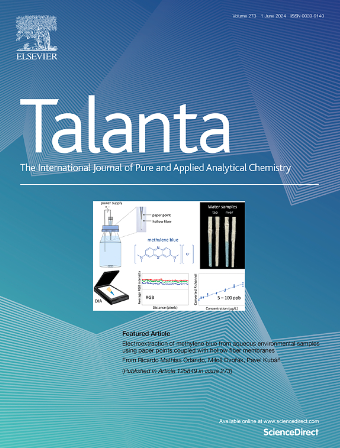钒氧化物化合物作为模拟酶:隐藏的催化能力
IF 5.6
1区 化学
Q1 CHEMISTRY, ANALYTICAL
引用次数: 0
摘要
纳米酶是一种创新的人工酶,由工程纳米材料制成,旨在解决天然酶的固有局限性,如昂贵的储存要求、缺乏结构稳定性和对化学物质的敏感性。近年来,钒基化合物因其优异的生物相容性、强大的催化性能和易于表面修饰而引起了人们的极大兴趣,使其成为生物传感和环境修复中有前途的候选者。本文综述了以钒为基础的模拟不同氧化还原酶的化合物,包括过氧化物酶-、过氧化氢酶-、氧化酶/漆酶-和超氧化物歧化酶样活性。此外,本文还对每一种由氧化钒基化合物构建的纳米酶的氧化还原酶功能的机制、最新进展和实际应用进行了深入的研究。简而言之,本文确定并讨论了目前氧化钒基化合物转化为可行应用的障碍,并为未来的研究方向提供了建议。本文章由计算机程序翻译,如有差异,请以英文原文为准。

Vanadium oxide compounds as mimic enzymes: hidden catalytic ability
Nanozymes, innovative artificial enzymes crafted from engineered nanomaterials, have been designed to address the inherent limitations of natural enzymes, such as expensive storage requirements, lack of structural stability, and sensitivity to chemicals. Vanadium oxide-based compounds have garnered significant interest lately, owing to their excellent biocompatibility, potent catalytic performance, and ease of surface modification, positioning them as a promising candidate for use in biosensing and environmental remediation. In this review, vanadium oxide-based compounds that mimicked different oxidoreductases, exhibiting peroxidase-, catalase-, oxidase/laccase-, and superoxide dismutase-like activities were summarized. Moreover, the current review offers an in-depth examination of the mechanisms, latest progress, and practical applications associated with each reported oxidoreductase-like function of nanozymes constructed from vanadium oxide-based compounds. In brief, this review identifies and discusses the present hurdles in the transition of vanadium oxide-based compounds into viable applications, providing recommendations for future research avenues.
求助全文
通过发布文献求助,成功后即可免费获取论文全文。
去求助
来源期刊

Talanta
化学-分析化学
CiteScore
12.30
自引率
4.90%
发文量
861
审稿时长
29 days
期刊介绍:
Talanta provides a forum for the publication of original research papers, short communications, and critical reviews in all branches of pure and applied analytical chemistry. Papers are evaluated based on established guidelines, including the fundamental nature of the study, scientific novelty, substantial improvement or advantage over existing technology or methods, and demonstrated analytical applicability. Original research papers on fundamental studies, and on novel sensor and instrumentation developments, are encouraged. Novel or improved applications in areas such as clinical and biological chemistry, environmental analysis, geochemistry, materials science and engineering, and analytical platforms for omics development are welcome.
Analytical performance of methods should be determined, including interference and matrix effects, and methods should be validated by comparison with a standard method, or analysis of a certified reference material. Simple spiking recoveries may not be sufficient. The developed method should especially comprise information on selectivity, sensitivity, detection limits, accuracy, and reliability. However, applying official validation or robustness studies to a routine method or technique does not necessarily constitute novelty. Proper statistical treatment of the data should be provided. Relevant literature should be cited, including related publications by the authors, and authors should discuss how their proposed methodology compares with previously reported methods.
 求助内容:
求助内容: 应助结果提醒方式:
应助结果提醒方式:


